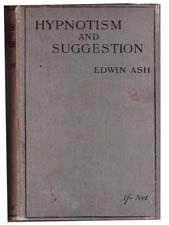
This slim little volume was good value at the original price. Intended to encourage medical practitioners to use hypnosis experimentally and therapeutically, it covers theory and practice with a clarity rare for the period.
A century after it was first published this is undoubtedly a fascinating source-book for anyone interested in the development of hypnotherapy. Drawing on the work of Mesmer, Esdaile, Braid, Charcot, Liebeault and Bernheim, Ash explains his own method, emphasising the importance of suggestion.
His own method is a combination of an eye fixation based on Braid and repeated suggestions, plus Mesmeric-like soothing ‘passes’. But he firmly denies any ‘animal magnetism’. In particular he notes that‘passes’ are ineffective if the subject does not know that hypnosis is intended, or is unaware that passes with no physical contact are in fact being made.
I found his eye fixation technique intriguing because he uses a Hypnoscope. This seems to have been commercially available and consisted of a one-inch concave mirror mounted on a matt black board like a hand mirror. The subject sat with the light behind him [usually a him] held the Hypnoscope, and stared at the bright mirror. For ages.
The whole technique took a long time and must have been tiring for subject and operator. One must admire the perseverance that produced all the case studies he reports.
He was, nevertheless, aware of instant inductions.
“A very useful means of rapid induction is to make a sudden pressure with one’s hand on the subject’s head, at the same time giving commands in a loud and decisive voice. There are various ways of doing this; for example, having placed the subject in a comfortable position, one stands in front of him with one hand held some distance above and in front of his face. Then rapidly bring the hand down so that the thumb rests in the centre of the forehead. Firm and increasing pressure is made by the thumb in a downward direction and one says in a firm manner:- “Now you cannot open your eyes” – or makes some similar suggestion. In many instances an early stage of hypnosis will be obtained at once and the suggestions accepted.”
He notes the inhibiting effect of sudden sounds or flashes of light and observes that “the sudden passing of an electric current through an unsuspecting person has been known to induce this condition”. Around that time there was a careless approach to using electricity therapeutically (and X-rays and radioactivity) but Ash seems to have been a practical man.
“These rapid methods although in some respects very showy are not as a rule productive of the deeper stages and the more important phenomena of hypnosis. Neither are they suitable for therapeutic purposes, serving rather to alarm a nervous patient than to inspire confidence and mental calm.”
He spends some time discussing the work which can be done in the various states. He also notes that narcotic drugs can be used to induce hypnosis – something I’ve tended to associate only with the KGB and CIA. He himself had obtained catalepsy in subjects ‘after a few breaths of chloroform’. And he mentions experiments with Cannabis Indica.
One experimenter recommended“administration of a dose sufficient to produce early toxic symptoms” (about 1 or 1.5 grains of the extract), when “some two hours after the administration there is noticed a stage of excitement soon followed by a condition of drowsiness; if suggestions are now given they will act as in hypnosis.” Another therapeutic dead-end!
I can’t say I would adopt any of his methods, but on the basis of this handbook Ash should be honoured for promoting ‘Suggestive Therapeutics’ and, to my mind, also for advocating that the medical profession should recognise, and use, lay practitioners of the art of hypnosis.
Elwyn Griffiths